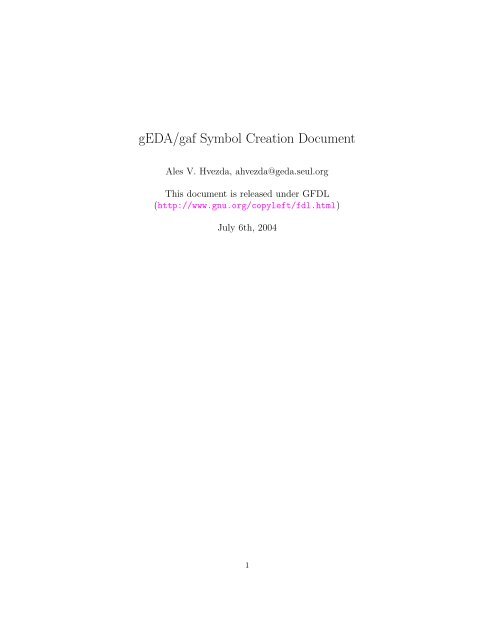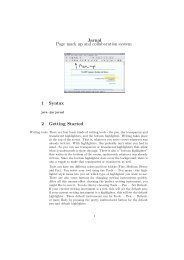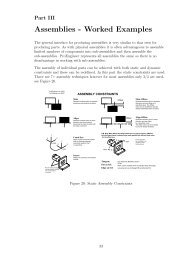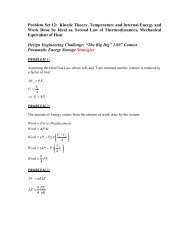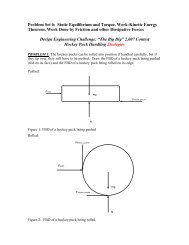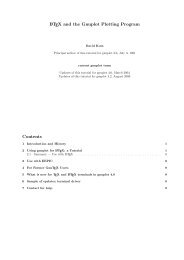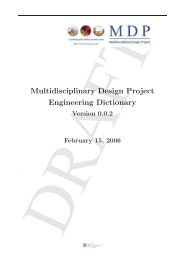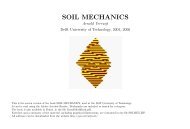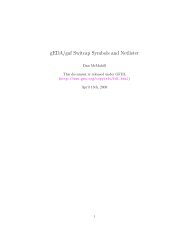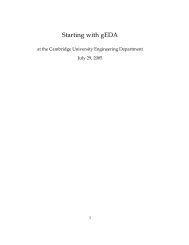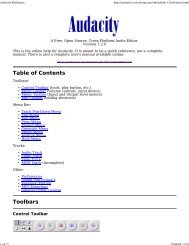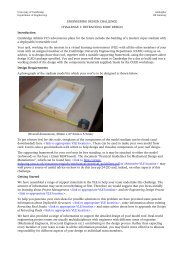gEDA/gaf Symbol Creation Document
gEDA/gaf Symbol Creation Document
gEDA/gaf Symbol Creation Document
You also want an ePaper? Increase the reach of your titles
YUMPU automatically turns print PDFs into web optimized ePapers that Google loves.
<strong>gEDA</strong>/<strong>gaf</strong> <strong>Symbol</strong> <strong>Creation</strong> <strong>Document</strong><br />
Ales V. Hvezda, ahvezda@geda.seul.org<br />
This document is released under GFDL<br />
(http://www.gnu.org/copyleft/fdl.html)<br />
July 6th, 2004<br />
1
Contents<br />
1 Overview 3<br />
2 Component symbol creation 3<br />
3 Requirements 4<br />
4 Style 5<br />
4.1 Text . . . . . . . . . . . . . . . . . . . . . . . . . . . . . . . . . . 5<br />
4.2 Attributes . . . . . . . . . . . . . . . . . . . . . . . . . . . . . . . 6<br />
4.3 Graphics . . . . . . . . . . . . . . . . . . . . . . . . . . . . . . . . 6<br />
4.4 Pins . . . . . . . . . . . . . . . . . . . . . . . . . . . . . . . . . . 6<br />
4.5 Electrical . . . . . . . . . . . . . . . . . . . . . . . . . . . . . . . 7<br />
5 Footprint naming conventions 8<br />
5.1 Notes . . . . . . . . . . . . . . . . . . . . . . . . . . . . . . . . . 8<br />
5.2 Integrated circuit packages . . . . . . . . . . . . . . . . . . . . . . 8<br />
5.3 Integrated circuit SMT packages . . . . . . . . . . . . . . . . . . 9<br />
5.4 Basic semiconductors . . . . . . . . . . . . . . . . . . . . . . . . . 10<br />
5.5 Basic SMT semiconductors . . . . . . . . . . . . . . . . . . . . . 10<br />
5.6 Passive components . . . . . . . . . . . . . . . . . . . . . . . . . 11<br />
5.7 Passive SMT components . . . . . . . . . . . . . . . . . . . . . . 11<br />
6 Hints and Tips 12<br />
7 Example 12<br />
8 <strong>Document</strong> Revision History 16<br />
2
1 Overview<br />
This document describes the creation of component symbols, including style<br />
conventions, and hints/tips and things to look out for when drawing symbols<br />
for the <strong>gEDA</strong>/<strong>gaf</strong> system.<br />
2 Component symbol creation<br />
Component symbols (from here on known as ”symbols”) are drawn using gschem<br />
just like drawing a schematic sheet. Here are the steps in a symbol in the<br />
<strong>gEDA</strong>/<strong>gaf</strong> system:<br />
1. Run gschem and find a blank page or run: gschem filename-1.sym<br />
2. Draw the symbol (see the style guide below for some conventions).<br />
3. Translate the symbol to the origin using Edit/<strong>Symbol</strong> Translate...<br />
• Zoom in at least one step.<br />
• Make sure the snap is ON (this is critical).<br />
• Make sure grid snap size is set to 100 (this is critical).<br />
• Select ”<strong>Symbol</strong> Translate...” or the press equivalent hotkey.<br />
• Enter 0 into the entry field and press OK.<br />
Translating the symbol to the origin is a required step. To translate a<br />
symbol elsewhere, enter a offset (in mils) which is a even multiple of 100.<br />
Make sure all pins are snapped to a 100 mil grid point.<br />
4. Save the symbol using Save or SaveAs... Here are some symbol naming<br />
conventions:<br />
• <strong>Symbol</strong>s are named: symbolname-#.sym<br />
• <strong>Symbol</strong>s end with a .sym extension.<br />
• <strong>Symbol</strong>s have a -# where # is a number. Typically # is 1 but<br />
if there are multiple symbols for a device then this number simply<br />
increments.<br />
• <strong>Symbol</strong> names are typically lowercase but letters which are part of a<br />
part number are uppercase.<br />
• The above case rule can be broken if the filename looks incorrect or<br />
wrong.<br />
5. Place the symbol in one of the directories specified by the componentlibrary<br />
keyword in the system-<strong>gaf</strong>rc file. Once this is done, the symbol<br />
should be visible immediately and can be selected and placed with the<br />
”Add/Select Component...” menu item.<br />
3
3 Requirements<br />
This section describes the various requirements which must be met in order to<br />
create a valid symbol which will display and netlist in the <strong>gEDA</strong>/<strong>gaf</strong> system.<br />
Most of the requirements center around having certain attributes attached or<br />
inside the symbol.<br />
Running gsymcheck will check that all of these requirements are met. gsymcheck<br />
will output fatal errors which are quite serious and must be corrected. gsymcheck<br />
will also output warnings on things which should be fixed but are not fatal.<br />
For more information on the attributes presented here, please see the Master<br />
Attribute <strong>Document</strong>.<br />
• device=DEVICENAME should be placed somewhere in the symbol and<br />
made invisible. device= is the device name and is required. Typically<br />
the devicename is in all caps (capital letters). This attribute should not<br />
be used as a label. Use a separate text object for the label. If the object<br />
is a graphic then device= should be set to none (device=none). It is no<br />
longer required to attach this attribute anything; just having it exist as<br />
device=DEVICENAME is good enough.<br />
• graphical=1 should exist somewhere in a symbol which is purely graphical<br />
(such as a title block or decon symbol). <strong>Symbol</strong>s which have this<br />
attribute have no electrical or circuit significance. Don’t forget to set<br />
device=none.<br />
• description=text should exist somewhere in the symbol. This attribute<br />
provides an one line description of the symbol.<br />
• All pins should have a pair of attributes attached to them: pinseq=#<br />
and pinnumber=#. The first attribute, pinseq=# is just a sequence<br />
number and increments sequentially starting at 1. The second attribute<br />
pinnumber=# is the number of the pin. When a symbol is netlisted, the<br />
pin numbers are output in order of pin sequence. The pin number can be<br />
alphanumeric (i.e. like E or C).<br />
• All pins should also have pinlabel=value attached to them. This attribute<br />
is the name or label of the pin (vs the pin number). This attribute is also<br />
used when a symbol is used in a hierarchical schematic. Please make this<br />
attribute green (instead of the default attribute yellow).<br />
• All pins should also have pintype=value attached to them. This attribute<br />
describes the kind of a pin. Possible values are: in, out, io, oc, oe, pas, tp,<br />
tri, clk, pwr. Please see the Master Attribute <strong>Document</strong> for more info.<br />
• If a component has multiple slots in a package (such as a 7400 (NAND)<br />
which has 4 NANDs per package) then you need a numslots=# attribute.<br />
4
The # is the number of slots the device has. numslots= should be exist<br />
somewhere in the symbol and made invisible. Additional slot related<br />
required attributes are described below.<br />
• If a component has multiple slots in a physical package then you also<br />
need to include a slotdef=#:#,#,#... for every slot. The first # corresponds<br />
to the slot number. If a device has 4 slots then there should be<br />
slotdef=1:..., slotdef=2:..., slotdef=3:..., and slotdef=4:..., attributes<br />
existing somewhere in the symbol and made invisible. The subsequent<br />
# have a one-to-one correspondence to pinseq=# attributes and specify<br />
what corresponding pinnumber=# should be when that slot is set. See<br />
The attached 7400-1.sym as an example of how this should all work.<br />
• It is recommended that all symbols which have slots have a slot=1 attribute<br />
inside the symbol.<br />
• footprint=PACKAGENAME should exist somewhere in the symbol which<br />
might be used with the PCB netlister. PACKAGENAME is the PCB<br />
footprint or package type like DIP14 or DIP40. Please see the Footprint<br />
naming conventions chapter for further detail. See also the PCB<br />
documentation and gnetlist/docs/README.pcb for more info on this attribute.<br />
• You should put a refdes=U attribute inside the symbol. Make only the<br />
value visible and it will be promoted (attached to the outside of the symbol<br />
(so it can be edited) when the symbol is placed in a schematic.<br />
• The label= attribute should not be attached anywhere in the symbol. It<br />
is obsolete.<br />
• The name= attribute should not be attached anywhere in the symbol.<br />
• The netname= attribute should not be attached anywhere in the symbol.<br />
It is only used in schematics.<br />
4 Style<br />
This section describes the style in which is used in the standard <strong>gEDA</strong>/<strong>gaf</strong><br />
symbol library.<br />
4.1 Text<br />
• All Text labels should all be 10 pt in size.<br />
• Text (labels not attributes) should be color number 9 (text — green).<br />
5
4.2 Attributes<br />
• Pin numbers (which are attributes) should all be 8 pt in size.<br />
• Attached attributes should be yellow. The color is set automatically to<br />
yellow if the text item is attached.<br />
• The only exception to this is pinlabel= attributes, those should be color<br />
number 9 (text — green). If every text item within a symbol is yellow,<br />
the symbol looks too yellow.<br />
• Attributes can be attached to some part of the symbol. Toplevel attributes<br />
(like the device= or net= attributes) used to be required to be attached to<br />
something to be attributes, but now they just have to exist in the symbol<br />
file as name=value.<br />
• Expanding a bit on the last sentence, as long as the text item has the<br />
format name=value, it is considered an attribute. Attributes inside a<br />
symbol do not have to be attached to anything. In order to see hidden<br />
attributes in gschem select Edit/Show/Hide Inv Text.<br />
• There is a symbol content versioning system in libgeda which is based on<br />
the symversion= attribute. Please see the Master Attribute <strong>Document</strong><br />
for more information on using this versioning scheme.<br />
4.3 Graphics<br />
• Lines, boxes, arcs, and any other graphics should be color number 3<br />
(graphic — green).<br />
• Polarity bubbles should be color number 6 (logic bubble — cyan)<br />
• If you are unsure on how to make a new symbol look or how big to make a<br />
new symbol, look at the existing symbols to get a feel for the appropriate<br />
appearance and size.<br />
4.4 Pins<br />
• Pins should all be 300 mils (3 grid spaces) long.<br />
• For pins which are next to a logic bubble, make the pins 200 mils (2 grid<br />
spaces) long and then make the logic bubble 100 mils in diameter. In<br />
order to draw a 100 mil diameter circle, you will need to change the snap<br />
spacing to 50.<br />
• A pin has two ends: one end has a red endpoint and one end that does<br />
not. The red endpoint is where nets can be connected. You can either<br />
rotate the pin so that this active end is in the right place or manually edit<br />
6
the symbol file changing the ”whichend” parameter on the pin object. See<br />
the File Format document for more info.<br />
• Be that all endpoints of pins which are meant to be connected to are on<br />
the 100 mil grid. The endpoint which is not active can be off the grid if<br />
necessary.<br />
• Pins should be color number 1 (pins — white).<br />
• Leave 400 mils (4 grid spaces) between (vertically) pins, unless you are<br />
drawing a special symbol, then just try to make it look good.<br />
• Pin number attributes should be 50 mils above (or below; which ever<br />
makes the most sense) the pin which they are attached to.<br />
• Input pins belong on the left and output pins belong on the right of the<br />
symbol.<br />
• Please do not mix inputs and outputs on the same side of the symbol,<br />
unless absolutely necessary.<br />
• You can have pins on the top or bottom of a symbol.<br />
• The order for rows of pins (buses) should be LSB (least significant bit) to<br />
MSB (most significant bit). When drawing pins which are part of a bus,<br />
make sure the LSB of the bus is at the top (or for pins on top/bottom<br />
of a symbol, left of the rest of the other pins). Look at 74/74181-1.sym<br />
for a correct example of this order (A0 on top through A3 and B0 on top<br />
through B3). Violating this rule will make connecting buses much more<br />
difficult.<br />
• When placing pins on logic gates, be sure to place the smallest pin numbers<br />
toward the top (or left) and then increment going down (or across).<br />
4.5 Electrical<br />
• Do not draw power and ground pins. That information will be conveyed<br />
using attributes (see the netattrib document).<br />
• The above rule can be broken if necessary, but keep in mind most of the<br />
standard library does not have power pins showing.<br />
• Keep in mind, symbols are supposed to be symbolic, they do not represent<br />
the physical package that the device comes in.<br />
• There is some disagreement on above, so this is okay too: Arrange the<br />
pins on a symbol logically so that they promote an uncluttered schematic.<br />
Note that this is frequently not the same pin arrangement as the physical<br />
device.<br />
7
5 Footprint naming conventions<br />
This section describes the conventions for naming of footprints used in <strong>gEDA</strong>/<strong>gaf</strong>.<br />
The purpose of the naming convention is to establish a standard to maintain<br />
the same naming convention through the different phases of the CAD chain.<br />
This helps in ensuring that the collaborative effort of <strong>gEDA</strong>/<strong>gaf</strong> is not lost.<br />
5.1 Notes<br />
• Unless otherwise noted, numerical pin names will be used, starting from<br />
1.<br />
• n is for the pin count.<br />
• m is for the pin spacing in mils.<br />
• x is for the x dimension of the package (excluding pins). In particular this<br />
is used for the QFP package family.<br />
• SMT means surface mount, other components are through-hole.<br />
5.2 Integrated circuit packages<br />
• Dual in line packages with up to 22 100 mil spaced pins and 300 mil row<br />
spacing are called DIPn.<br />
• Dual in line packages with 24 or more 100 mil spaced pins and 300 mil<br />
row spacing are called DIPnN.<br />
• Dual in line packages with 100 mil spaced pins and 400 mil row spacing<br />
are called DIPnH.<br />
• Dual in line packages with 24 or more 100 mil spaced pins and 600 mil<br />
row spacing are called DIPn.<br />
• Shrink dual in line packages with up to 24 70 mil spaced pins and 300 mil<br />
row spacing are called SDIPn.<br />
• Shrink dual in line packages with more than 24 70 mil spaced pins and<br />
400 mil row spacing are called SDIPn.<br />
• Single in line packages with 100 mil spaced pins are called SIPnN. See also<br />
JUMPER, below.<br />
• Zig-zag in-line package are called ZIPn.<br />
• Plastic leadless chip carrier with pin socket are called PLCCnX.<br />
8
5.3 Integrated circuit SMT packages<br />
• Small outline SMT packages with up to 16 50 mil spaced pins and 150 mil<br />
total width are called SOn.<br />
• Small outline SMT packages with more than 16 50 mil spaced pins and<br />
150 mil total width are called SOnN.<br />
• Small outline SMT packages with 50 mil spaced pins and 200 mil total<br />
width are called SOnM.<br />
• Small outline SMT packages with up to 20 50 mil spaced pins and 300 mil<br />
total width are called SOnW.<br />
• Small outline SMT packages with more than 20 50 mil spaced pins and<br />
300 mil total width are called SOn.<br />
• Small outline SMT packages with 44 or more 50 mil spaced pins and 525<br />
mil total width are called SOn.<br />
• Metric shrink small outline SMT packages with 0.65 mm spaced pins and<br />
323 mil total width are called MSSOPn. NOTE: To be confirmed.<br />
• Metric shrink small outline SMT packages with up to 44 0.65 mm spaced<br />
pins and 420 mil total width are called MSSOPnW.<br />
• Metric shrink small outline SMT packages with over 44 0.65 mm spaced<br />
pins and 545 mil total width are called MSSOPnW.<br />
• Shrink small outline SMT packages with 0.25 mil spaced pins and 420 mil<br />
total width are called SSOPnW.<br />
• Quarter size small outline SMT packages with 0.25 mil spaced pins and<br />
244 mil total width are called SSOPn.<br />
• Thin small outline SMT packages with 0.2165 mil spaced pins and 535 mil<br />
total width are called TSOPn.<br />
• Thin small outline SMT packages with 0.20 mil spaced pins and 795 mil<br />
total width are called TSOPnA.<br />
• Thin small outline SMT packages with 0.20 mil spaced pins and 559 mil<br />
total width are called TSOPnB.<br />
• Thin shrink small outline SMT packages with up to 28 0.26 mil spaced<br />
pins and 260 mil total width are called TSSOPn.<br />
• Thin shrink small outline SMT packages with over 28 0.20 mil spaced pins<br />
and 319 mil total width are called TSSOPn.<br />
• Ultra Super Mini SMT packages with up to 16 0.5 mm spaced pins are<br />
called USn.<br />
9
• Plastic leadless chip carrier SMT are called PLCCn.<br />
• Square quad-side flat pack SMT are called QFPn x.<br />
• Rectangular quad-side flat pack SMT are called QFPn R.<br />
• Square low profile quad-side flat pack SMT are called LQFPn x.<br />
• Square thin quad-side flat pack SMT are called TQFPn x.<br />
• Square Quad-side flat no-lead SMT without exposed paddle (back side<br />
contact) are called QFNn x. Pin count is n and package size is x mm.<br />
• Square Quad-side flat no-lead SMT with exposed paddle (back side contact)<br />
are called QFNn x EP. Pin count is n and package size is x mm.<br />
• Thin profile square Quad-side flat no-lead SMT without exposed paddle<br />
(back side contact) are called TQFNn x. Pin count is n and package size is<br />
x mm.<br />
• Thin profile square Quad-side flat no-lead SMT with exposed paddle (back<br />
side contact) are called TQFNn x EP. Pin count is n and package size is x<br />
mm.<br />
• Dual in line style crystal oscillators are OSC8 and OSC14.<br />
• 5 pin SOT SMT packages are SOT25 and SOT325.<br />
• 6 pin SOT SMT packages are SOT26 and SOT326.<br />
5.4 Basic semiconductors<br />
• Axial diodes are called ALFm. Pin 1 is the cathode.<br />
• Conventional through hole LED is LED3 and LED5 for 3 and 5 mm respectively.<br />
Pin 1 is plus. NOTE: Should probably be changed to be in line with<br />
diode convention.<br />
• TO transistors are TO5, TO92, TO126, TO220 etc. Suffixes may apply, e.g.<br />
TO126W is for wide, TO126S is for standing, TO126SW is for standing, wide.<br />
5.5 Basic SMT semiconductors<br />
• SOD diode SMT packages use their standard package name, e.g. SOD80,<br />
SOD87, SOD106A, SOD110. There are also SOD123, SOD323 with narrow<br />
pads.<br />
• SOT transistor SMT packages use their standard package name, e.g. SOT23,<br />
SOT323. There is also an SC90.<br />
10
• SOT transistor SMT packages with numbering as for diodes (pin 1 is<br />
cathode, pin 2 anode) are SOT23D, SOT323D.<br />
• 4 pin SOT SMT packages are SOT89, SOT143, SOT223.<br />
5.6 Passive components<br />
• Axial non-polar components (typically resistor, capacitor) are called ACYm.<br />
• Bottom lead (radial) non-polar circular component (typically capacitor)<br />
is RCYm.<br />
• Bottom lead non-polar rectangular component (typically capacitor) is<br />
BREm.<br />
• A standard crystal is HC49, or other HC designations as required.<br />
• Single row 100 mil pin spacing jumpers are JUMPERn. The main difference<br />
compared to single in line package is the hole size.<br />
• Dual row 100 mil spacing headers with DIP pin numbering are HEADERn 1.<br />
Note that n is an even number.<br />
• Dual row 100 mil spacing headers with ribbon cable numbering are HEADERn 2.<br />
Note that n is an even number.<br />
• Angled full header connectors with latches are DIN41651 n.<br />
• Standing full header connectors with latches are DIN41651 nS.<br />
• DSUB connectors female are DBnF.<br />
• DSUB connectors male are DBnM.<br />
• Female DIN card-to-card connectors are DIN41612CnF. Add S suffix for<br />
standing.<br />
• Male DIN card-to-card connectors are DIN41612CnM. Add S suffix for<br />
standing.<br />
• AMP modular RJ connectors with screen are RJ11, RJ12 and RJ45.<br />
5.7 Passive SMT components<br />
• Standard SMT resistors, inductors, capacitors etc are 0201, 0402, 0603,<br />
0805, 1206, 1210, 1806, 1812, 1825, 2020, 2706.<br />
• Tantalum SMT capacitors are EIA3216, EIA3528, EIA6032, and EIA7343.<br />
Pin 1 is plus.<br />
• SMT electrolytics are designated by can diameter in 1/10 mm: SME33,<br />
SME43, SME53, SME66, SME84, SME104.<br />
11
6 Hints and Tips<br />
This section describes some hints and tips which will make your symbol creation<br />
experience easier.<br />
• Avoid drawing things off of the grid. If you do, you cannot move the<br />
object(s) using the move command (if the grid is on) since the object will<br />
be snapped to the grid. [This was an old bug, which I think has been<br />
fixed, but avoid doing this anyway]. Use the symbol translate command<br />
instead (or move the object with grid snap off)<br />
• If you need a finer grid then use Options/Snap Grid Spacing... to set a<br />
finer grid snap spacing. Just remember to set this back to 100 once you<br />
are ready to translate the symbol to the origin.<br />
• If you want to translate a symbol from the origin to elsewhere, then use<br />
the ”<strong>Symbol</strong> translate” command and enter a non zero number. Make<br />
sure this number is a multiple of 100 (ie 1000, or 1100).<br />
• Pins MUST be snapped on the 100 spaced grid (at least the end which<br />
will have nets connected to it).<br />
• Pins MUST be snapped on the 100 spaced grid (at least the end which<br />
will have nets connected to it). Yes this is line a duplicate. I can’t stress<br />
this point enough.<br />
• Remember that pins are special objects; if you want to add a pin, make<br />
sure it is a pin and not a line or net. Use the Add/Pin command to place<br />
a pin.<br />
• Don’t include nets or buses inside symbols. That is not supported and<br />
doesn’t make much sense anyway.<br />
7 Example<br />
This section provides a simple example which tries to follow all of the above<br />
rules. This symbol is of a 7400 (NAND gate).<br />
v 20020825<br />
L 300 200 300 800 3 0 0 0 -1 -1<br />
T 300 0 9 8 1 0 0 0<br />
7400<br />
L 300 800 700 800 3 0 0 0 -1 -1<br />
T 500 900 5 10 0 0 0 0<br />
device=7400<br />
12
T 500 1100 5 10 0 0 0 0<br />
slot=1<br />
T 500 1300 5 10 0 0 0 0<br />
numslots=4<br />
T 500 1500 5 10 0 0 0 0<br />
slotdef=1:1,2,3<br />
T 500 1700 5 10 0 0 0 0<br />
slotdef=2:4,5,6<br />
T 500 1900 5 10 0 0 0 0<br />
slotdef=3:9,10,8<br />
T 500 2100 5 10 0 0 0 0<br />
slotdef=4:12,13,11<br />
L 300 200 700 200 3 0 0 0 -1 -1<br />
A 700 500 300 270 180 3 0 0 0 -1 -1<br />
V 1050 500 50 6 0 0 0 -1 -1 0 -1 -1 -1 -1 -1<br />
P 1100 500 1300 500 1<br />
{<br />
T 1100 550 5 8 1 1 0 0<br />
pinnumber=3<br />
T 1100 450 5 8 0 1 0 2<br />
pinseq=3<br />
T 950 500 9 8 0 1 0 6<br />
pinlabel=Y<br />
T 950 500 5 8 0 1 0 8<br />
pintype=out<br />
}<br />
P 300 300 0 300 1<br />
{<br />
T 200 350 5 8 1 1 0 6<br />
pinnumber=2<br />
T 200 250 5 8 0 1 0 8<br />
pinseq=2<br />
T 350 300 9 8 0 1 0 0<br />
pinlabel=B<br />
T 350 300 5 8 0 1 0 2<br />
pintype=in<br />
}<br />
P 300 700 0 700 1<br />
{<br />
T 200 750 5 8 1 1 0 6<br />
pinnumber=1<br />
T 200 650 5 8 0 1 0 8<br />
pinseq=1<br />
T 350 700 9 8 0 1 0 0<br />
pinlabel=A<br />
T 350 700 5 8 0 1 0 2<br />
13
pintype=in<br />
}<br />
T 300 900 8 10 1 1 0 0<br />
refdes=U<br />
T 500 2250 5 10 0 0 0 0<br />
footprint=DIP14<br />
T 500 2450 5 10 0 0 0 0<br />
description=4 NAND gates with 2 inputs<br />
T 500 2650 5 10 0 0 0 0<br />
documentation=http://www-s.ti.com/sc/ds/sn74ls00.pdf<br />
T 500 2850 5 10 0 0 0 0<br />
net=Vcc:14<br />
T 500 3050 5 10 0 0 0 0<br />
net=GND:7<br />
This example produces the following (using gschem):<br />
1<br />
2<br />
U<br />
7400<br />
3<br />
This is the same symbol with all the hidden text visible (via Edit/Show/Hide<br />
Inv Text):<br />
14
1<br />
1<br />
2<br />
2<br />
slotdef=4:12,13,11<br />
slotdef=3:9,10,8<br />
slotdef=2:4,5,6<br />
slotdef=1:1,2,3<br />
numslots=4<br />
slot=1<br />
U device=7400<br />
A<br />
in<br />
B<br />
in<br />
7400<br />
net=GND:7<br />
net=Vcc:14<br />
documentation=http://www-s.ti.com/sc/ds/sn74ls00.pdf<br />
description=4 NAND gates with 2 inputs<br />
footprint=DIP14<br />
Y<br />
out<br />
3<br />
3<br />
15
8 <strong>Document</strong> Revision History<br />
September 14th, 2002<br />
October 31st, 2002<br />
February 11th, 2003<br />
September 27th, 2003<br />
July 6th, 2004<br />
Created symbol.tex from symbols.html<br />
Fixed bad example symbol<br />
Footprint naming conventions added<br />
Applied Dan McMahill’s QFP and QFN patch<br />
Added a bunch more details/hints to the pin section<br />
16


